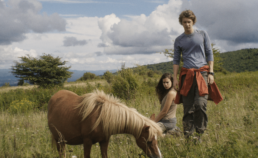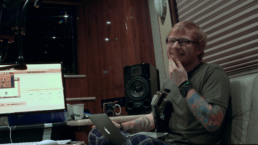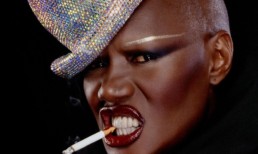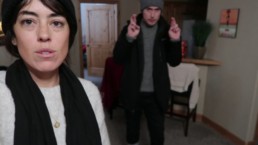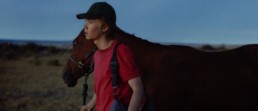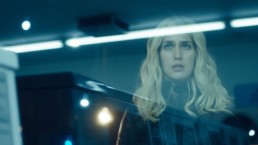'Maine' Review: A Bittersweet Missed Connection on the Appalachian Trail
One of my favorite films from the Tribeca Film Festival was one that I hadn't even planned on seeing.
Luckily, I happened to stumble upon a ticket on the day of the screening and after watching Matthew Brown's bittersweet and affecting drama, I believe I was destined to see Maine on that day. Fleeting love and missed connections are all too familiar situations that happen in everyday life, yet the number of films that successfully tackle these complex and heartbreaking feelings is very few. In Maine, Brown embraces the romance of nature and creates a love story that may be devoid of a stereotypical happy ending, but does not shortchange on emotional satisfaction.
Laia Costa and Thomas Mann play two hikers on a journey, both literally and figuratively, who cross paths while on the Appalachian Trail. When we meet thirty-something Bluebird (Costa) and twenty-something Lake (Mann), their relationship seems like it goes back for years, even though they had only met days prior. Their comfort around each other is evident in their horseplay, light flirtation, and jokiness– the word 'privacy' means nothing to them (public urination isn't taboo– in fact, we learn that an awkward bathroom situation is how they first met). Each of them is saddled with personal baggage– Bluebird as a married woman but insisting on independence and Lake, more reserved of the two, struggling to find his sense of purpose and direction.
The intimacy of the environment and their growing bond comes to a head when, after getting caught up in the moment, Bluebird and Lake kiss. Even though the affection is mutual, Bluebird makes it clear that she cannot continue to put herself in this position with Lake, she is married after all. Understanding but obviously disappointed, Lake does the best he can to get through the next couple of days until Bluebird leaves the trail for home. Under different circumstances, it seems like this relationship could have thrived, but the reality is that not everything that seems meant to be, will be. This makes one question: Can the heart make a mistake? Can loving someone be wrong?
Under different circumstances, it seems like this relationship could have thrived, but the reality is that not everything that seems meant to be, will be.
Maine is an intimate film set in a remote location in the backwoods of Maine (filming on the actual Appalachian Trail was prohibited) with only a handful of cast members, but the intense effect this film had on me was lasting. Laia Costa's performance as a conflicted woman torn between her head and her heart hit all the right emotional notes, while also keeping it light in the film's funnier moments. Bluebird has the personality of a grown-up Moonie from The Florida Project and that is a wonderfully refreshing thing to see on screen. Thomas Mann grounds Costa's energetic performance as the sensitive and emotionally-developed Lake, and watching his heart get broken is one of the hardest things to sit through.
Director Matthew Brown's aesthetic choices, like filming in square 1:66:1 format and keeping the production close to the vest, are all details that make Maine feel so authentic. Jessica Lea Mayfield's 2008 song 'For Today,' off of her "With Blasphemy So Heartfelt" album, is the perfect musical companion to Maine– highlighting the tenderness and vulnerability both Lake and Bluebird experience throughout their journey, both individually and together. Brown's decision to stay on a close-up shot of Bluebird while Lake sings an acoustic rendition of 'For Today' is one of the film's most powerful moments. We see Lake come out of his shell as he embodies the lyrics over the course of the four-minute song while Bluebird can't help but ride an emotional rollercoaster that draws us in. It's moments like these that make this low-key film stand out as a wonderfully unconventional love story.
'Maine' is 85 minutes.
'Songwriter': Watch Ed Sheeran Create His Most Personal Album
Ed Sheeran fans rejoice: the English singer-songwriter is getting candid by inviting viewers to take an intimate look into his artistic process in the documentary, Songwriter.
Directed by his cousin, Murray Cummings, the documentary follows Sheeran throughout the creation of his chart-topping album "÷" (divide) which, after just one week on sale, became the biggest-selling album of 2017. From early jam sessions in his tour van to brainstorming lyrics and chords with friends in Malibu, Songwriter is the ultimate film for Sheeran groupies, music fans, and anyone pursuing a creative passion.
Ed Sheeran is more than just a talented singer – that we know. His songs have found their way on to multiple “Best of” lists and his last record, "x" (multiply), earned him his first No. 1 spot on the Billboard 200. But what sets him apart from others in the industry– besides his shaggy red hair and colorful tattoos– is the authenticity in his music and his poetic way with words. Sheeran is involved in writing all of his own songs, a process that is taxing yet ultimately rewarding and is fascinating to see play out on the big screen.
The phrase "it takes a village" is at the core of Sheeran's success, and the film does a fantastic job of showing how much he values and depends on collaboration and input from his creative team, which includes musician Foy Vance, producer Benny Blanco, and his brother Matthew, among other singer-songwriters. Seeing (and hearing) their ideas bouncing around the room gives off a vibe of infectious happiness and an "anything is possible" attitude. Much like the Showtime documentary, Lost Songs: The Basement Tapes Continued, Songwriter is an equally powerful look into the writing and recording process that is neither as glamorous nor as easy as one may think.
Sheeran is involved in writing all of his own songs, a process that is taxing yet ultimately rewarding and is fascinating to see play out on the big screen.
Director Murray Cummings incorporates archival footage from Ed's younger days that show just how far back his passion for music goes. We see him learning how to play multiple instruments, get a glimpse into his family home life, and revisit his high school days. Seeing Sheeran’s determination and grit to get to where he is today will only gain him more respect as an artist.
Songwriter plays also like a private acoustic concert for an hour and a half. Sheeran's talent is undeniable– even when dressed in a green t-shirt, blue plaid pajama pants, and fuzzy moccasins– his soothing and uplifting voice is always on point, a juxtaposition that makes for some (perhaps unintentionally) funny moments.
I personally will never tire of music documentaries, and Songwriter is a beautifully composed and inspiring addition to this genre. Fun fact: at one point Sheeran admits that this is the first time he has ever written a song on camera, an act that typically leaves him feeling self-conscious. Songwriter
'Songwriter' is 84 minutes.
'Grace Jones: Bloodlight And Bami' Review: This Enigmatic, Fierce Feminist Belongs on the Big Screen
In 2015, Grace Jones released a memoir called I'll Never Write My Memoirs.
In it, along with proving that she is not one to be labeled “predictable”, Jones made the divisive claim that Beyonce, Miley Cyrus, Lady Gaga, and other pop stars are guilty of copying her style. This, of course, caused a social media firestorm among the generation that was too young to know 'who this Grace Jones person' was – how dare she insult Queen Bey! In the long-awaited and (apparently) much-needed re-introduction, director Sophie Fiennes gives audiences a rare look at this controversial, multi-hyphenated artist in the documentary-meets-art house film, Grace Jones: Bloodlight And Bami. The result is a product that may make millennials think twice before discrediting Jones as a self-proclaimed “Original”.
Filmed over a ten-year span and throughout various countries, Fiennes has created a quintessential profile piece with Bloodlight And Bami that explores Grace Jones far beyond her controversial statements and tabloid headlines. Through hotel room conversations, intimate family dinners, and private recording studio sessions, audiences see Jones as a mother, a church-goer, and a daughter, among other personal monikers. Most of the film takes place in Jamaica, Jones' birthplace, and audiences are thrust into the center of her family dynamic. Perhaps the most revelatory fact is Jones' admission of an abusive relationship with her step-father, and the lasting effect it had on her. Yet she also credits the man, who she calls Mas P, for inspiring her extremely masculine and 'scary' onstage persona.
Approach this film with an open mind and prepare for it to get blown away by the wildly wonderful Grace Jones.
Watching Grace's creative process from early studio sessions to her live performances of “Slave To The Rhythm” and “Pull Up To The Bumper” are perhaps among the film's most fascinating scenes. Like a true artist, she performs without inhibition (except when she thinks she looks like a lady pimp with call girls as backup dancers) and follows an 'art over money' philosophy that is inspiring to anyone pursuing creative dreams.
Much like Jones herself, Fiennes' filmmaking style is a reflection of her innovation. This type of filmmaking includes using film that looks dated, including glitches and lags, and switches between more intimate, fly-on-the-wall moments to energetic live performances.
For as inclusionary as the film's content tries to be, it seems like if one is not already a Grace Jones superfan or particularly interested in the 80s music scene, Bloodlight And Bami can feel exclusionary. No scene is particularly set up, leaving the audience to find themselves dropped into the middle of a moment without prior context, which can feel confusing and exacerbating during long takes. The take away is to go in without expecting this to be a straightforward documentary, as Bloodlight And Bami is not trying to be the next Amy. Approach this film with an open mind and prepare for it to get blown away by the wildly wonderful Grace Jones.
'Grace Jones: Bloodlight And Bami' is not rated. 115 minutes. Opening this Friday at the NuArt Theatre in Los Angeles with opening night Q&As for the 7:00 pm & 9:45 pm showings with Grace Jones and filmmaker Sophie Fiennes.
vlog no. 004 | Sundance Film Festival 3/3
A behind-the-scenes look at the 2018 Sundance Film Festival. Part 3.
On Camera: Morgan Rojas, Ryan Rojas
Editing by: Morgan Rojas
♫Music By♫
Joakim Karud - Loudness Clarity
Song/Free Download - https://youtu.be/4yFAnw2U_uA
Support Joakim Karud - http://smarturl.it/joakimkarud
vlog no. 003 | Sundance Film Festival 2/3
A behind-the-scenes look at the 2018 Sundance Film Festival. Part 2.
On Camera: Morgan Rojas, Ryan Rojas
Editing by: Morgan Rojas
♫Music By♫
Joakim Karud - No Worries (feat. Dyalla)
Song - https://youtu.be/4E6Erhc0UaY
Dyalla - http://smarturl.it/Dyalla
Joakim Karud - Boost Song - https://youtu.be/cvOvQloDp14
Follow Joakim Karud - http://smarturl.it/joakimkarud
DJ Quads - Circus Song - https://youtu.be/VIoH-sYxoy4
Follow DJ Quads - http://smarturl.it/dj-quads
vlog no. 002 | Sundance Film Festival 1/3
A behind-the-scenes look at the 2018 Sundance Film Festival. Part 1.
On Camera: Morgan Rojas, Ryan Rojas
Editing by: Morgan Rojas
Camera Assistance: Flynn Mitchell
♫Music By♫
Dreams by Joakim Karud https://soundcloud.com/joakimkarud
Creative Commons — Attribution-ShareAlike 3.0 Unported— CC BY-SA 3.0
http://creativecommons.org/licenses/b...
Music promoted by Audio Library https://youtu.be/VF9_dCo6JT4
♫Music By♫
Joakim Karud - Loudness Clarity
Song/Free Download - https://youtu.be/4yFAnw2U_uA
Support Joakim Karud - http://smarturl.it/joakimkarud
'Lean on Pete' is a Stunning Companion Film Full of Heartache and Triumph
Last year, it was Luca Guadagnino's visceral drama Call Me By Your Name that transported audiences to the remote village of Crema, Italy, where we felt the warm summer breeze on our skin, tasted the juices of the perfectly-ripened fruit, and got that all-too-real pit in our stomach that only first love can give.
While the "cinematic" year is just getting started, it seems like Lean on Pete is British-born director Andrew Haigh's answer to last year's aforementioned Best Picture Oscar-nominee. The visual and emotional vibrancy of Lean on Pete, plus the powerful performance from breakout star Charlie Plummer, radiates from the screen and will easily make its way into your heart.
Sixteen-year-old Charley Thompson (Charlie Plummer) and his father Ray (Travis Fimmel) have a dysfunctional relationship, that is apparent early on. They love each other dearly but Ray is not financially stable, and his emotional capacity is constantly being distracted by various women he brings home. Because of his upbringing, his mother left the family when he was young, Charley has always been an independent kid longing for connection. So when he finds a job at a local horse racetrack working alongside Del Montgomery (Steve Buscemi) and jockey Bonnie (Chloë Sevigny), Charley feels complete. Del and Bonnie fill the role of "family," and Charley becomes emotionally attached to one of Del's older horses, named Lean on Pete. However, when Charley learns that Pete is being sent to the slaughter, he feels not only betrayed by the people he considered his chosen family but heartbroken at the thought that his best friend was going to be discarded in such a horrific way. Charley won't let that happen and so, with Pete in one hand and a couple bucks in his pocket, he sets out across the Midwest to escape the harsh reality in hopes of a promising future ahead in the great unknown.
While the story isn't an original idea– Andrew Haigh adapted Lean on Pete from Willy Vlautin's novel of the same name– Haigh makes this story an unforgettable cinematic experience. Heartbreaking and beautiful, we follow Charley as he makes his way through rough terrain, both literally and figuratively as he navigates through the harsh environments and a messy personal life. Charley experiences various tragedies and Pete becomes a sort of emotional support animal for him. It is a heartwarming moment, once realized, that just as Charley saved Pete from an unethical death, Pete saved Charley from total loneliness.
It is a heartwarming moment, once realized, that just as Charley saved Pete from an unethical death, Pete saved Charley from total loneliness.
Coming off of last year's role as the kidnapped J. Paul Getty III in All the Money in the World, Charlie Plummer does an outstanding job holding it all together as the headstrong yet naive and underprivileged teen. The tension bubbles and tears well behind his eyes, but the attitude he adopts as Charley doesn't allow him to let his vulnerability show. It is during certain moments of the film, when this vulnerability peaks through his tough exterior, that we see a child who is aching for stability in any form. The supporting performances from Buscemi and Sevigny are full of depth and evoke a wide range of emotions. The environment is also very much a character in itself as the brutal landscape and places within it provide Charley and Pete with benefits or deterrents. However, Charley seems to always come out the other side having learned from the experience.
Lean on Pete is divided into three distinct parts, perhaps serving as an homage to the book, but at times it can feel like three different movies. The motivation deters slightly throughout each part, but the emotional impact of Charley's end goal remains consistent and strong. It will be hard to get through the film with dry eyes, but its lasting satisfaction and tenderness make it all worth it.
121 minutes. Lean on Pete is rated R for language and brief violence. Opening this Friday at The Landmark and ArcLight Hollywood.
'Gemini' Review: No One is Innocent in the City of Angels
Much like how Nicolas Winding Refn's 2011 drama Drive saw Ryan Gosling explore the seedy underbelly of Los Angeles after dark, Aaron Katz's Gemini follows much of the same cinematic aesthetic.
Lola Kirke and Zoë Kravitz star in this crime thriller where, after a mysterious murder is discovered in a starlet's Hollywood Hills mansion, everyone is a suspect. It may be called the City of Angels, but no one is innocent here.
Jill (Kirke) is so much more than a devoted assistant to celebrity Heather Anderson (Kravitz). She is the breaker of bad news when Heather doesn't want to deal with confrontation, she is a trusted second opinion when Heather asks her what she thinks about her new relationship with a woman, but above everything else, Jill is Heather's best friend. After a night of dealing with obsessive fans and intruding paparazzi, Heather confides in Jill that she never feels safe and is always on edge. She then asks Jill if she can borrow her gun just as a precautionary measure. Hesitant but ultimately concerned for her safety, Jill agrees and gives Heather the gun.
When a murder is discovered in Heather's mansion the next morning, all signs point to Jill. It was her gun, her prints on the casings, and she was the last one to see the victim alive. Or was she? Detective Edward Ahn (John Cho) seems to think Jill isn't telling him everything she knows, but the truth is, even Jill doesn't know how deep and twisted this situation actually is.
'Gemini' is a subtle reminder that no one can withstand that amount of pressure for too long. They are bound to break. Or kill.
Reminiscent of Olivier Assayas' Personal Shopper (starring Kristen Stewart) with subtle hints of another Refn classic The Neon Demon (starring Elle Fanning), Gemini is a dark and dreamy little film. It is a bit slow to get going, although the opening long shot of muted purple upside-down palm trees sets the aesthetic for what's to come, Gemini ultimately suffers from a lack of plausibility and a strong final act. For as realistic and deep-rooted into Los Angeles as we get, like hole in the wall bars and even a cameo from Hotel Normandie in Koreatown, the audience is really made to suspend their disbelief to an unnatural point at the film's climax. To be blunt, the big reveal turns out to be pretty silly.
All that to say, Gemini is a sensational visual and audible experience. Aaron Katz captures a pulsating and stylized version of Los Angeles that is not typically seen in feature films. Lola Kirke and Zoë Kravitz are both engaging to watch on screen, and their chemistry as friends is undeniable. Composer Keegan DeWitt is quickly becoming a Cinemacy favorite, having scored indie gems like Newness and The Long Dumb Road. He adopts a moody and synthetic tone for Gemini (perhaps taking inspiration from Kavinsky and Lovefoxxx's Nightcall) that, not surprisingly, is a perfect companion to the film.
No matter one's profession, social media following, or number of friends, one thing is universal– we all need protection, stability, and a sense of safety in order to get through life. Getting a glimpse at the chaos of celebrity life and how normalized the invasion of privacy has become, Gemini is a subtle reminder that no one can withstand that amount of pressure for too long. They are bound to break. Or kill.

